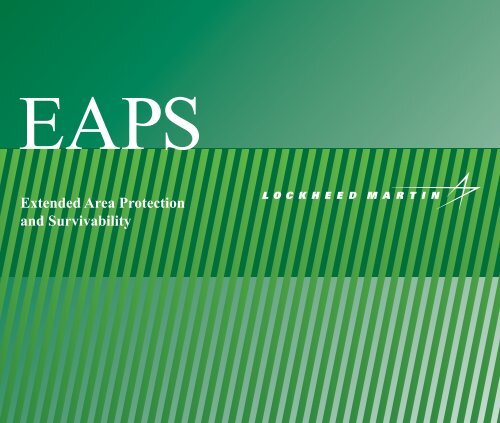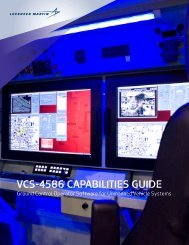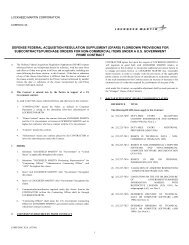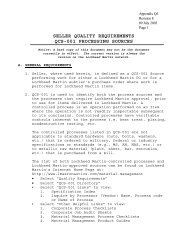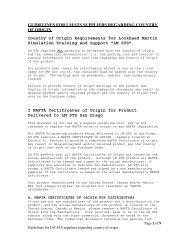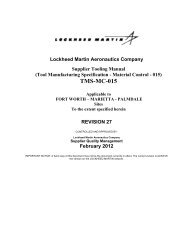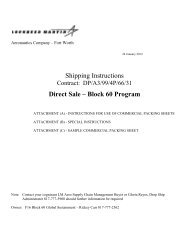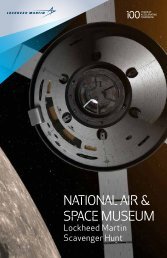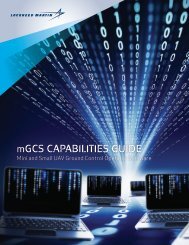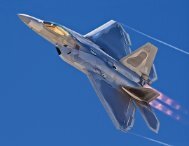EAPS - Lockheed Martin
EAPS - Lockheed Martin
EAPS - Lockheed Martin
- No tags were found...
You also want an ePaper? Increase the reach of your titles
YUMPU automatically turns print PDFs into web optimized ePapers that Google loves.
Shooter System EmploymentEngagement Sequence••••Counter Rocket Artillery and Mortar (C-RAM) C2 or surveillance asset passesRAM threat to shooter via Technical Fire ControlTechnical Fire Control receives threat data and manages engagementsInterceptor launches and flies toward an anticipated acquisition pointAt the acquisition point the interceptor seeker locks onto and guides to thereflected signalBody-to-body impact destroys the incoming threat•TechnicalFire ControlAESA FireControl SensorIlluminateTargetVerticalLaunchTrajectoryShapingHit-to-KillInterceptNLOS LauncherThreat• Rockets• Artillery• MortarsFeatureCompactHit-to-Kill InterceptorDefended radius2.5+ kmCommon operatingpictureBenefit• 135 interceptors/launcher• Protect and respond insame launcher• Logistics/supportability/MANPRINT• Large reduction in shootermanpower• 90-134 km 3 defendedbattlespace• Effective battlespacemanagement
Miniature Hit-to-Kill InterceptorDelivers Unequalled Capability• Operational effectiveness against all threats- Lethality tests confirm robust capability- Range and velocity support operationally significant defended area• Defeat of saturation attacks- Compact interceptor enables deep magazine- High lethality minimizes rounds fired to achieve a kill• Low ammunition cost- Affordability considered in all design trades- Design for Affordability/Design for Manufacture used early- $16K or less per kill• Minimal/low potential for collateral damage- Single round fired per target- Hit-to-Kill results in destruction of interceptor and threat• Minimal force structure impact
Low Cost, Robust LethalityMiniature Hit-to-Kill (HTK) Interceptor••Arena testing confirms assured lethality against all RAM threatsCombines the benefits of high agility, semi-active guidance and accuracy toachieve body-to-body impact at low costCompact size allows dense load out of 135 interceptors/launcher•Design CharacteristicsSeekerHigh frequencyLengthLess than 75 cmDiameterLess than 7 cmLaunch WeightLess than 5 kgEngagement Range Beyond 3 km, threat dependent
Fire Control System SolutionExtends the Battlespace• Operational effectiveness against all threats- 360° coverage- Detection range to support lethal engagements• Defeat of saturation attacks- AESA supports multiple simultaneous engagements- 360° coverage• Low ammunition cost• Minimal/low potential for collateral damage• Minimal force structure impact
135 Interceptors per NLOS LauncherLauncher•••MCCSOperational Launcher15 AURs{AURMAMCLUMCCSMAMAll Up Round9 MHTKIPackage1 AURMissile Adapter ModuleContainerized Launch UnitMissile Computer &Communication SystemSizeParameterWeightLoad OutEmplacementTransportabilityReload TimeCommunicationLinkPositionalAccuracy/NLOSNavigation UnitDesign Parameters forObjective LauncherValueAUR fits launcher cell
•••••Technical Fire Control Node Tiesthe Shooter System into Existing ArchitectureOperational effectiveness against all threatsDefeat of saturation attacksLow ammunition costMinimal/low potential for collateral damageMinimal force structure impact--Leverages experience/capabilities used on existing programsCompact, portable footprint
Man Portable and Provenon Existing ProgramsTechnical Fire Control Node•••COTS-based, man-portableDesign and algorithms based on MEADS, THAAD and LEAPP experienceFAAD C2 interface compatibility eases integration to C-RAMsystem-of-systemsAlso supports stand-alone operation needs•ObjectiveMaxVision’s ® MaxCubeDesign Parameters forObjective Technical Fire ControlDesign ParametersProcessing PowerMemoryDisk SpaceSizeWeight120 GFLOPSUp to 12 GBUp to 8 TBValue32 cm x 32 cm x 28 cm
•••••Deployable System EnablesOperational FlexibilityOperational effectiveness against all threatsDefeat of saturation attacksLow ammunition costMinimal/low potential for collateral damageMinimal force structure impact--All system elements C-130 transportableOperational capability on a single C-130
Battalion Area ProtectionIn a Single C-130• Minimum deployed capability:1 AESA FCS + HMMWV- FCS on MTV with Integral Power/Thermal Management- Tech FC deployed as laptopon the FCS- 135 interceptors in HMMWVmounted NLOS launcherTotal: One Battle Element(540 Interceptors) =Two C-130 Sorties• 405 interceptors =one C-130 sortie- 135 interceptors in eachof 3 HMMWV mountedNLOS launchers
Robust, Low Costand Proven Lethality• Operational effectiveness against all threats- Lethality tests confirm robust capability vs hardest targets• Defeat of saturation attacks• Low ammunition cost• Minimal/low potential for collateral damage- Intercept results in destruction of incoming threatand interceptor• Minimal force structure impact
Proven LethalityVia Body-to-Body ImpactMortarArtillerySuccessful LethalityTest Series –Summer 2007The robust lethality of thedesign was validated bydefeating the hardest andthickest mortar and artillerytargets under tactical conditions.• Defeated hardest/thickest walled targets at tactical velocities- Mortar- Artillery• Data gathered---Supports lethality and margin analysesValidates modeling (allows extension of performance against all targets)National lab assets are supporting extended lethality analyses
Operational Benefits to the Soldier••••Operational effectiveness againstall threatsDefeat saturation attacksLow ammunition costMinimal/low potential forcollateral damageMinimal force structure impact•
Operational BenefitsOperationalImperativesLethal Against EntireRAM Threat SetDefeat SaturationAttacksLow Collateral DamageMinimize Impact onForce StructureLow Interceptor CostPer Kill (
•••••Program Plan Proves Key Technologiesand Positions the Army for SDDOperationally effective against all threatsDefeat saturation attacksLow ammunition costMinimal/low potential for collateral damageMinimal force structure impact
Demonstration Program DeliversTactical Missile for TestingPhase 1 Phase 2 Phase 3 Phase 4 Phase 5ATP DR-1 (9) DR-2 Phase 3 EOCTracking TestPhase 4 EOC Phase 5 EOC(60)Fire Control IntegrationLauncher IntegrationInterceptor Design and DevelopmentHWIL HW/SW IntegrationHWILAMRDECHWIL DemoSIL Flight Acceptance Testing Interceptor - Launcher -TFCN - FC Sensor Emulator - C2 CRAM EmulatorLM/AMRDEC HWIL Interceptor with BE Emulators and ModelsBattle Element Field Test Integration and Simulation ModelsCTV/GTV Tests<strong>Lockheed</strong> <strong>Martin</strong> Funded Objective System Design MaturationWe test and deliver a mature interceptor demonstrating key system elementsthrough the AMRDEC <strong>EAPS</strong> Integrated Demonstration Program
<strong>EAPS</strong>Extended Area Protectionand SurvivabilityPartnering to Protect SoldiersIn Their Defining Moments
Performance• Effective against all threats• Defeats saturation attacks• Minimal/low collateral damageAffordability• Low ammunition cost• Minimal force structure impact<strong>Lockheed</strong> <strong>Martin</strong>Missiles and Fire Control<strong>EAPS</strong> – Extended Area Protection and SurvivabilityProgram Director: Steve Kress 972.603.9638Program Manager: Billy Brassell 972.603.1668Business Development: Chris Murphy 972.603.9397
www.lockheed martin.com/mfcMaxCube is a registered trademark of MaxVision Corporation. All rights reserved.NLOS, THAAD and LEAPP are trademarks of <strong>Lockheed</strong> <strong>Martin</strong> Corporation. All rights reserved.© Copyright 2008 <strong>Lockheed</strong> <strong>Martin</strong> Corporation. All rights reserved.


